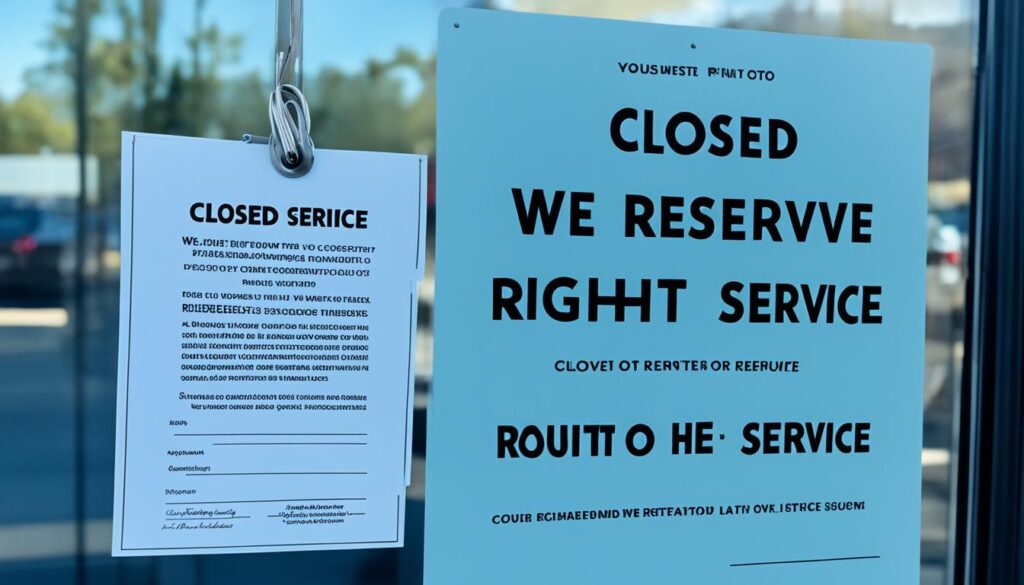In the course of running a business, there may be situations where it becomes necessary to deny service to a customer. This could be due to various reasons such as an inability to meet their specific needs or a request that goes against your company’s policies. However, it is essential to handle these situations with care and professionalism, ensuring that the customer’s satisfaction and your brand’s reputation remain intact.
Polite communication is key when declining customer requests. By employing empathetic and considerate responses, you can maintain positive relationships with your customers while improving overall customer service. It is important to offer alternative solutions whenever possible, demonstrating your commitment to meeting their needs in a different way.
In this article, we will explore the best practices for politely declining a customer’s request. We will provide examples and templates that you can use to craft your own responses, ensuring that your communication remains professional and empathetic. We will also discuss the importance of staying connected with customers and maintaining relationships even after declining a request.
Key Takeaways:
- When denying service to a customer, it is crucial to do so politely and respectfully.
- Offer alternative solutions to meet the customer’s needs and maintain positive relationships.
- Follow best practices such as using a positive tone, personalizing responses, and asking for customer feedback.
- Understand the situations where it is acceptable to reject a customer’s request based on company policies and behavior.
- Awareness of the legal considerations and potential consequences of refusing service is essential to protect your business.
The Importance of Polite Declination and Alternative Solutions
When it comes to handling customer requests, declining them in a polite and considerate manner is crucial. By avoiding direct refusals and instead offering alternative solutions, you can maintain valuable relationships with your customers while also improving your overall customer services. The impact of this approach can be seen in boosted retention rates and increased customer satisfaction.
When you decline a customer’s request in a polite manner, it shows that you value their business and respects their needs. This respectful interaction can help to preserve the relationship you have built with the customer and even enhance it over time. By providing alternative solutions, you are demonstrating your commitment to finding a resolution that meets their needs, even if their initial request cannot be fulfilled.
Furthermore, offering alternatives allows you to showcase your dedication to customer service and your willingness to go above and beyond to find a solution. This not only boosts customer satisfaction but also helps to build trust and loyalty, which are essential for long-term relationships.
But how can you effectively decline a customer’s request while still maintaining their trust and loyalty?
Strategies for Politely Declining Customer Requests:
- 1. Listen actively to their request: Take the time to fully understand the customer’s needs and concerns before providing a response.
- 2. Respond with empathy: Show understanding and empathy towards the customer’s situation, acknowledging their request sincerely.
- 3. Keep replies short and simple: Avoid lengthy explanations and maintain a concise and respectful tone in your communication.
- 4. Explain the rejection with clarity: Clearly explain the reasons why their request cannot be fulfilled in a transparent and straightforward manner.
- 5. Use a positive tone: Frame your response in a positive manner, highlighting any potential alternatives or benefits they may still enjoy.
- 6. Personalize the response: Tailor your message to address the customer’s specific concerns and needs, making them feel valued and heard.
- 7. Offer alternative options: Provide alternative solutions or suggestions that can still meet the customer’s needs or solve their problem.
- 8. Ask for customer feedback: Invite the customer to share their thoughts or offer further suggestions, demonstrating that their input is important to you.
By following these strategies, you can effectively decline customer requests while nurturing your relationships and improving your customer services. The next section will delve deeper into best practices for politely declining a customer’s request, providing examples and templates for your reference.

Best Practices for Politely Declining a Customer’s Request
When it comes to handling customer requests that you cannot fulfill, it’s essential to approach the situation with empathy and professionalism. By following these best practices, you can ensure that the customer feels heard and valued, despite not being able to fulfill their request.
1. Listen to customer requests
Start by actively listening to the customer’s request and understanding their needs. This shows that you value their input and are genuinely interested in finding a solution.
2. Communicate with empathy
Empathetic communication is the key to making the customer feel understood and acknowledged. Show understanding for their situation and assure them that their request has been taken seriously.
3. Offer a sincere apology
Apologize to the customer for not being able to fulfill their request. A sincere apology goes a long way in maintaining a positive relationship with the customer.
4. Keep replies short and simple
Avoid lengthy and complex explanations when declining a customer’s request. Keep your replies concise and straightforward, focusing on the main points.
5. Explain the rejection with clarity
Clearly explain why you’re unable to fulfill the customer’s request. Provide them with a transparent and honest explanation to help them understand the situation better.
6. Use a positive tone
Even when delivering bad news, maintain a positive and optimistic tone. This helps alleviate any negative feelings and ensures the customer doesn’t feel discouraged.
7. Personalize the response
Show that you value the customer by personalizing your response. Address them by name and make them feel that their request was given individual attention.
8. Offer alternative options
Suggest alternative solutions or products that may meet the customer’s needs. By offering alternatives, you show that you’re willing to help them find a suitable solution, even if it’s not exactly what they initially requested.
9. Ask for customer feedback
After declining the request, ask the customer for their feedback on how you handled the situation. This shows that you genuinely care about their opinion and opens up the opportunity for further dialogue.
10. Learn from the experience
Take each declined request as a learning opportunity. Analyze the situation and identify any areas for improvement, both in terms of your processes and how you communicate with customers.
By implementing these best practices, you can navigate the delicate task of politely declining a customer’s request while maintaining a positive customer experience. Remember, it’s about delivering the message with empathy, understanding, and a commitment to customer satisfaction.

When It Is Acceptable to Reject a Customer’s Request
In some situations, it may be necessary to reject a customer’s request. As a business, it is important to establish clear guidelines and policies to ensure consistency and uphold your brand’s reputation. Here are some scenarios in which it is acceptable to reject a customer’s request:
- The request goes against company policies: If the customer’s request is in direct conflict with your company’s policies, it is appropriate to decline. For example, if your policy states that certain customizations or changes are not allowed, you can politely inform the customer of this limitation.
- The request involves the disclosure of confidential information: If the customer’s request requires you to share confidential or sensitive information, it is necessary to decline. Protecting the privacy of your business and your customers should always be a priority.
- The request involves rude behavior or threats: If a customer demonstrates rude or disrespectful behavior, it is acceptable to reject their request. Remember to always maintain professionalism and address their concerns in a calm and respectful manner.
- The request asks for preferential treatment: If a customer asks for special favors or privileges that are not available to other customers, you can politely explain that you treat all customers equally and cannot provide preferential treatment.
Example:
Customer Request: “I demand to be given VIP treatment and priority service.”
Your Response: “Thank you for your interest in our business. While we value all our customers, we strive to provide equal service to everyone. We cannot offer preferential treatment, as it is important for us to maintain fairness and consistency across all customer interactions.”
By understanding when it is appropriate to reject a customer’s request, you can protect your company’s interests while maintaining professionalism and customer satisfaction. It is crucial to communicate your decision respectfully and offer alternative solutions whenever possible. Remember, your customers’ experience should always be a top priority.
Legal Considerations for Refusing Service to Customers
Refusing service to customers is not a decision to be taken lightly. It’s essential to have a clear understanding of the legal rights and obligations associated with such situations. By familiarizing yourself with the relevant laws, you can protect your business and minimize the risk of potential lawsuits.
- Legal rights to refuse service: As a business owner, you have the right to refuse service to customers under certain circumstances. However, it is crucial to ensure that your reasons for refusal comply with the law and do not violate anti-discrimination regulations.
- Anti-discrimination laws: At the federal level, the Civil Rights Act of 1964 prohibits discrimination based on race, color, religion, sex, or national origin. Additionally, the Americans with Disabilities Act (ADA) prohibits discrimination against individuals with disabilities.
- Protected classes: Anti-discrimination laws specify protected classes of individuals who are safeguarded from discrimination in various contexts. These classes typically include race, color, religion, sex, national origin, disability, and sometimes age, pregnancy, or genetic information, depending on the jurisdiction.
Understanding the intricacies of anti-discrimination laws, including the Civil Rights Act of 1964 and the ADA, will help ensure that you do not inadvertently violate these statutes when refusing service. By treating all customers fairly and equally, you can avoid potential legal issues and maintain a positive reputation for your business.

It’s worth noting that anti-discrimination laws may vary at the state and local levels, so it’s essential to familiarize yourself with the specific regulations in your jurisdiction to ensure compliance.
By following the appropriate legal guidelines, respecting the rights of individuals from protected classes, and understanding the potential implications of refusing service, you can navigate these situations responsibly and minimize the risk of legal disputes.
Potential Consequences of Denying Service to Customers
When businesses deny service to customers, there can be potential consequences that they need to be aware of. It is essential to carefully consider these consequences and weigh them against the reasons for denying service. By understanding the potential risks, businesses can make informed decisions and take appropriate actions to mitigate any negative impacts.
Legal Consequences
- Legal Action: Denying service to a customer without valid legal grounds can result in legal consequences. Customers may take legal action against the business, leading to lawsuits, financial penalties, and potential damage to the brand’s reputation.
- Reputation Damage: Denying service can lead to reputation damage for businesses. Negative publicity, such as news articles or social media coverage, can harm the brand’s image and credibility, potentially resulting in a loss of customers and revenue.

Negative Social Media Posts and Online Reviews
Denying service to a customer can trigger negative social media posts and online reviews, which can quickly spread and damage a business’s reputation. Unsatisfied customers may share their negative experiences on various platforms, reaching a wide audience and potentially dissuading others from engaging with the brand.
Customer Backlash
Customers who feel unfairly denied service may exhibit a strong negative reaction, leading to customer backlash. This can manifest in various ways, such as spreading negative word-of-mouth, boycotting the business, or actively seeking alternatives, all of which can result in a loss of customers and revenue.
Consequences of Denying Service to Customers
| Consequences | Description |
|---|---|
| Legal Action | This can result in lawsuits, financial penalties, and damage to the brand’s reputation. |
| Reputation Damage | Negative publicity and loss of trust from customers, potentially leading to a decrease in revenue. |
| Negative Social Media Posts and Online Reviews | Unhappy customers can share their experiences, damaging the brand’s image and dissuading others from engaging. |
| Customer Backlash | Customers may boycott the business or actively seek alternatives, resulting in revenue loss. |
Tips for Politely Refusing Customer Requests: Examples and Templates
Effectively managing customer requests sometimes requires the challenging task of saying ‘no’. However, it is crucial to do so in a polite and considerate manner to maintain a positive customer relationship. Here are some valuable tips and examples to help you politely decline customer requests while preserving professionalism and empathy.
Tips for Politely Refusing Customer Requests:
- Listen attentively and empathize with the customer’s request. Let them know that you understand their needs.
- Begin your response with a polite salutation and express appreciation for their interest or inquiry.
- Keep your reply short and simple, focusing on clarity and transparency.
- Clearly explain the reason for the refusal without sounding dismissive or negative.
- Use a positive tone throughout your message to convey respect and empathy.
- Personalize the response by addressing the customer by name and acknowledging their specific request.
- Offer alternative options or suggestions that may address the customer’s needs or concerns.
- End the email with a sincere expression of gratitude for their understanding and continued support.
- Invite them to provide feedback or reach out if they have any further questions or concerns.
Remember, these tips are meant to guide you in shaping your responses to customer requests. Tailor each email to the specific situation and customer, ensuring that your communication reflects your brand’s values and commitment to exceptional service. Now, let’s take a look at some example refusal emails and templates for declining customer requests:
Example Refusal Email:
Dear [Customer Name],
Thank you for reaching out to us with your request for [specific product/service]. We genuinely appreciate your interest in our offerings.
After careful consideration and a thorough review of your request, we regret to inform you that we are unable to fulfill it at this time. We understand the importance of [specific need], and we apologize for any inconvenience this may cause.
However, we would like to suggest an alternative option that might meet your requirements. [Provide details of the alternative option]. We believe this option might provide a suitable solution for your needs and would be happy to assist you further in exploring this alternative.
Once again, we apologize for any disappointment this may have caused. If you have any additional questions or require further assistance, please don’t hesitate to reach out to us. We value your feedback and strive to improve based on our customers’ needs.
Thank you for your understanding and continued support.
Warm regards,
[Your Name]
Template for Declining Customer Requests:
Dear [Customer Name],
Thank you for considering [Your Company Name] as your [specific product/service] provider. We appreciate your interest and the opportunity to serve you.
After careful consideration, we regret to inform you that we are unable to fulfill your request for [specific product/service] at this time. We truly understand the importance of [specific need], and we apologize for any inconvenience this may cause.
While we are unable to meet your request as specified, we would like to offer alternative options that may better suit your needs. Our team of experts is available to discuss your requirements and provide personalized recommendations. Please feel free to contact us at [phone/email] to explore these alternatives further.
Once again, we apologize for any disappointment this may have caused. We genuinely value your interest in our products/services and remain committed to providing exceptional customer experience. If you have any questions or require further assistance, please don’t hesitate to reach out to us.
Thank you for your understanding and support.
Best regards,
Maintaining Customer Relationships After Declining a Request
When it comes to customer service, it’s important to remember that maintaining positive relationships is key. Even when you have to decline a customer’s request, there are strategies you can employ to stay connected and continue providing support. By following these tips, you can ensure that your customers feel valued and understood, even in the face of a denial.
One way to maintain customer relationships after declining a request is by staying connected. Regularly reaching out to your customers through personalized emails or newsletters can help keep your brand top of mind and show that you’re still there to support them. Offering helpful content such as tips, industry news, or relevant resources demonstrates your commitment to their success.
Additionally, it’s important to reach back out to customers when you are able to fulfill their request in the future. By proactively following up and letting them know that their initial request is back on the table, you can show that you haven’t forgotten about their needs. This initiative can help rebuild trust and strengthen your relationship with the customer.
Ultimately, the key to maintaining customer relationships after denying a request is to provide ongoing support and demonstrate your dedication to their satisfaction. By staying connected, providing helpful content, and reaching back out when you are able to fulfill their request, you can ensure that customers continue to see value in your brand and choose to remain loyal.
FAQ
How can I politely decline a customer’s request?
When declining a customer’s request, it is important to do so in a polite and considerate manner. Instead of a straight-up negative refusal, offer alternative solutions and maintain relationships with customers. This approach can help boost retention rates and increase customer satisfaction.
What are the best practices for politely declining a customer’s request?
The best practices for politely declining a customer’s request include actively listening to customer requests, communicating with empathy, offering a sincere apology, keeping replies short and simple, explaining the rejection with clarity, using a positive tone, personalizing the response, offering alternative options, and asking for customer feedback. Following these practices will ensure professional and considerate communication.
In which situations is it acceptable to reject a customer’s request?
It is acceptable to reject a customer’s request in situations where the request goes against company policies, involves the disclosure of confidential information, involves rude behavior or threats, or requests preferential treatment. By understanding when it is appropriate to reject a customer’s request, businesses can protect their interests and maintain professionalism.
What are the legal considerations for refusing service to customers?
The legal considerations for refusing service to customers include the rights of businesses to refuse service, anti-discrimination laws at the federal, state, and local levels, protected classes, the Civil Rights Act of 1964, and the Americans with Disabilities Act. Business owners should understand their legal obligations and potential risks associated with refusing service to customers.
What are the potential consequences of denying service to customers?
The potential consequences of denying service to customers include legal action, reputation damage, negative social media posts, and online reviews. It is important for businesses to consider these potential consequences and weigh them against the reasons for denying service. By understanding the risks, businesses can make informed decisions and take appropriate actions to mitigate any negative impacts.
Can you provide tips and examples for politely refusing customer requests?
Yes, this section will provide tips and examples for politely refusing customer requests. These examples and templates will serve as a guide for businesses in crafting their own responses to customers, ensuring professionalism and empathy in handling customer requests.
How can I maintain customer relationships after declining a request?
To maintain customer relationships after declining a request, it is important to stay connected with customers, provide helpful content, and reach back out when able to fulfill the request in the future. By implementing these strategies, businesses can demonstrate their commitment to customer satisfaction and build long-term relationships.
